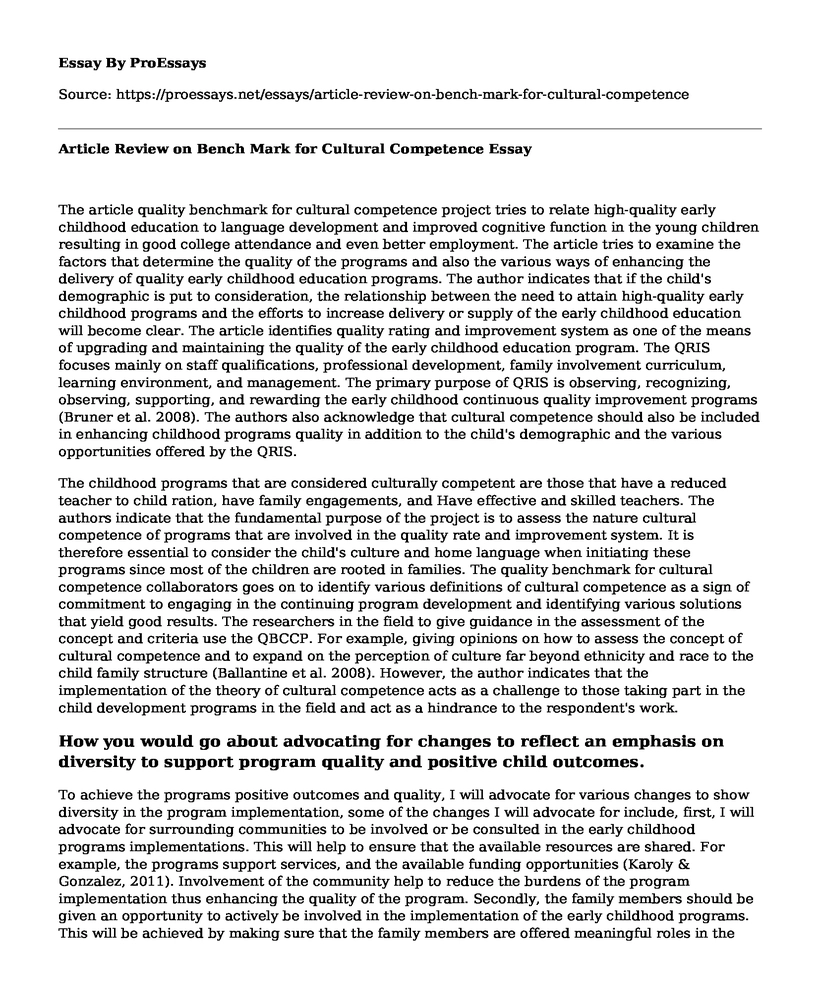The article quality benchmark for cultural competence project tries to relate high-quality early childhood education to language development and improved cognitive function in the young children resulting in good college attendance and even better employment. The article tries to examine the factors that determine the quality of the programs and also the various ways of enhancing the delivery of quality early childhood education programs. The author indicates that if the child's demographic is put to consideration, the relationship between the need to attain high-quality early childhood programs and the efforts to increase delivery or supply of the early childhood education will become clear. The article identifies quality rating and improvement system as one of the means of upgrading and maintaining the quality of the early childhood education program. The QRIS focuses mainly on staff qualifications, professional development, family involvement curriculum, learning environment, and management. The primary purpose of QRIS is observing, recognizing, observing, supporting, and rewarding the early childhood continuous quality improvement programs (Bruner et al. 2008). The authors also acknowledge that cultural competence should also be included in enhancing childhood programs quality in addition to the child's demographic and the various opportunities offered by the QRIS.
The childhood programs that are considered culturally competent are those that have a reduced teacher to child ration, have family engagements, and Have effective and skilled teachers. The authors indicate that the fundamental purpose of the project is to assess the nature cultural competence of programs that are involved in the quality rate and improvement system. It is therefore essential to consider the child's culture and home language when initiating these programs since most of the children are rooted in families. The quality benchmark for cultural competence collaborators goes on to identify various definitions of cultural competence as a sign of commitment to engaging in the continuing program development and identifying various solutions that yield good results. The researchers in the field to give guidance in the assessment of the concept and criteria use the QBCCP. For example, giving opinions on how to assess the concept of cultural competence and to expand on the perception of culture far beyond ethnicity and race to the child family structure (Ballantine et al. 2008). However, the author indicates that the implementation of the theory of cultural competence acts as a challenge to those taking part in the child development programs in the field and act as a hindrance to the respondent's work.
How you would go about advocating for changes to reflect an emphasis on diversity to support program quality and positive child outcomes.
To achieve the programs positive outcomes and quality, I will advocate for various changes to show diversity in the program implementation, some of the changes I will advocate for include, first, I will advocate for surrounding communities to be involved or be consulted in the early childhood programs implementations. This will help to ensure that the available resources are shared. For example, the programs support services, and the available funding opportunities (Karoly & Gonzalez, 2011). Involvement of the community help to reduce the burdens of the program implementation thus enhancing the quality of the program. Secondly, the family members should be given an opportunity to actively be involved in the implementation of the early childhood programs. This will be achieved by making sure that the family members are offered meaningful roles in the programs such as being part of the early childhood program board. Involving the parents or the family members will help generate useful information about the children in the specific area that will help improve the quality of the programs.
References
Bruner, C., M. Stover Wright, A. Copeman, A. Ray, D. Schaack. (2008).Preliminary Report Highlights: State QRIS Systems and Cultural and Linguistic Diversity. http://www11.georgetown.edu/research/gucchd/nccc/documents/FamilySupports.pdf.
Ballantyne, K., A. Sanderman, T. D'Emilio, N. McLaughlin. (2008). dual-language Learners in the Early Years: Getting Ready to Succeed inSchool. Washington: National Clearinghouse for English language acquisition. Online:http://www.ncela.gwu.edu/resabout/ecell/earlyyears.pdf.
Karoly, L. A., & Gonzalez, G. C. (2011). Early care and education for children in immigrant families. The Future of Children, 71-101.
Cite this page
Article Review on Bench Mark for Cultural Competence. (2022, Sep 21). Retrieved from https://proessays.net/essays/article-review-on-bench-mark-for-cultural-competence
If you are the original author of this essay and no longer wish to have it published on the ProEssays website, please click below to request its removal:
- My First Snowfall in America Essay Example
- Developmental Red Flags - Essay Sample
- Research Paper on Current Reform on Coverage and Payment of the Health Insurance
- Impact of Single Parenthood on a Child's Development - Research Paper
- Essay Example on Engaging Students With Work Stations to Build Literacy Skills
- Local Governments Grapple With Financial Crises: Bowling Green Kentucky Case Study
- Essay Example on Internet's Influence on English Language: John and Humphry's Views







